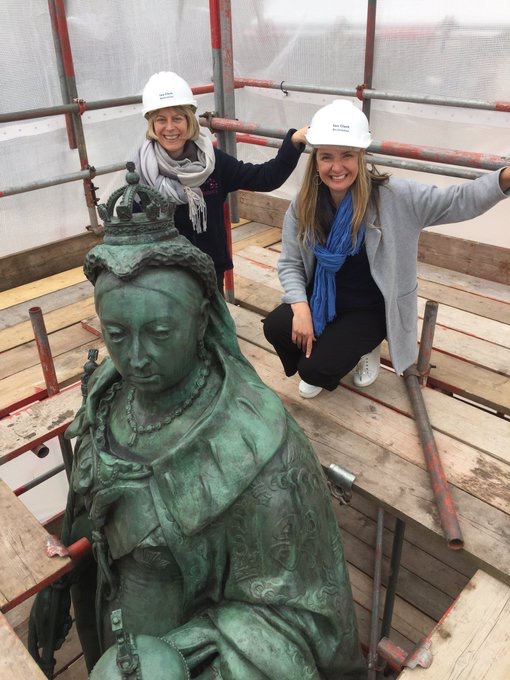Sarah Bragg, Headteacher of Park Road School from 1896-1932, now St Alphege Infants School, Solihull.
Our normal approach to developing resources and workshops uses real objects and historic imagery as a basis for learning. However, a recent request, which includes some first person interpretation of a Victorian school teacher, has led us in another direction. Mindful to ensure that the role-play does not fall into the trap of becoming a caricature, we’ve been on the lookout for a ‘real person’ to base the character on. In Sue Bates’ excellent History of Solihull, we found reference to a Miss Sarah Bragg, headteacher from 1896-1932 at Park Road school, the site where the Infants School is today. We were struck by her 36 long years of service, spanning a time of great change; the reigns of three monarchs, World War I, The Suffragette movement and the aftermath of the Wall Street Crash. Her obituary records that Sarah was “a fine teacher and a keen disciplinarian”, and that her gentleness and courtesy endeared her to anyone she met. Outside of her work at school, she appears to have played no other role in public life in the town.
The nature of schooling in the 19th Century centred on the formation of good character traits amongst pupils and Sarah would have taught within this rigid system. The Elementary Education Act of 1870 made education compulsory for all children between 5-13 and by 1891 this schooling became free of charge to those pupils’ families. This led to an increased number of pupils attending school and, in Solihull, a new school was built for older boys in Mill Lane, with Park Road school remaining a school for girls and infants. This was the school that Sarah joined as a new teacher in the mid 1890’s.

Sarah was the daughter of the well-known Bragg family of Solihull. They played an active role in Solihull life and were builders, butchers, bakers and funeral directors. Sarah lived most of her life with her mother and father, John and Esther, and is listed as resident with them on the censuses from 1871 -1911. She was the eldest child and had a sister, Lillian, and three brothers, Charles, John Archibald and Archer. As a child she lived in Mill Lane, now one of the busiest shopping streets in Solihull and, at the turn of the century when she was working at school, she lived in Park Road, just along from her place of work.
With the coming of the railway to Solihull in 1852, more and more people were able to live in the area and commute into Birmingham. This created a growing need for new homes. Charles Bragg, Building Contractor and uncle to Sarah, built a fine row of houses on Church Hill Road. Three Bragg families as well as a bank manager and an ironware manufacturer took up resident in the attractive new homes. In a house that still stands today, lived Sarah, her parents and brothers but by 1917, both of her parents had died. She never married and, in order to remain in her job at the time, it was necessary for her to be a single woman.

When she retired she was presented with a beautifully illuminated testimonial from 450 ex-pupils. Sadly, within a few years of retirement, Sarah passed away. She was living in Broomfields Avenue by then and, it was said, she left her heart at the school. She is buried in St Alphege Churchyard, alongside her mother and father and just a stone’s throw from the school she so loved.
Unfortunately, there is wear and tear on the grave and the stone cross is no longer attached to the headstone. How fitting it would be to honour this fine citizen of the town by making the repairs needed to her place of rest. Sarah, played an influential role in shaping the lives of the young people in her care and we should consider carefully how we continue to remember her, and people like her. We can so easily become complacent to the contributions that teachers and carers, just like Sarah, make in our communities and to remember them, honourably, is an important mark of respect.
With many thanks to Solihull Library, Heritage & Local Studies and Beryl Waters for images and information.





 Highlights have included working on Lottery funded James Watt 2019 and in particular our collaboration with the pupils and teachers at James Watt Primary School in Handsworth. Thanks to Avery Weigh-Tronix we were able to take children to visit the famous Soho Foundry just a short walk from the school. On the way, we discovered forgotten streets, hidden watercourses and intriguing stories of local parkland, Black Patch.
Highlights have included working on Lottery funded James Watt 2019 and in particular our collaboration with the pupils and teachers at James Watt Primary School in Handsworth. Thanks to Avery Weigh-Tronix we were able to take children to visit the famous Soho Foundry just a short walk from the school. On the way, we discovered forgotten streets, hidden watercourses and intriguing stories of local parkland, Black Patch. Museums Trust, The National Trust and The Coffin Works. We’ve shared methods of engaging families, presenting the past and even a whistle-stop history of Birmingham through BMT heritage sites. It’s a real bonus to offer these sessions in welcoming and friendly historic surroundings.
Museums Trust, The National Trust and The Coffin Works. We’ve shared methods of engaging families, presenting the past and even a whistle-stop history of Birmingham through BMT heritage sites. It’s a real bonus to offer these sessions in welcoming and friendly historic surroundings.









